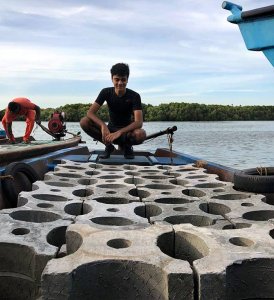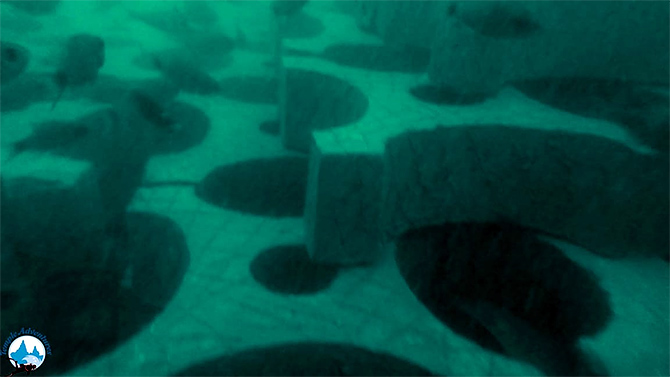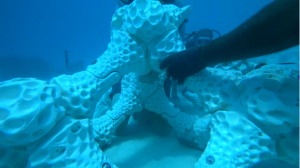Worldwide, there have been plenty of efforts to 3D print artificial coral reefs. Ever since Alex Goad invented the Modular Artificial Reef Structure, better known as MARS, and funded Reef Design Lab in Australia, he sparked a lot of interest in this type of 3D printed structures. Now, a seventeen-year-old student from Mumbai has also created his own 3D printed coral reef in Pondicherry, a quaint beachfront city in the Eastern coast of India very popular among scuba divers. A scuba diver himself, Siddharth Pillai, said in many interviews with local news outlets that he has been actively diving for the past five years, and during that time he witnessed first-hand how rising ocean temperatures have bleached coral outcrops. In May 2018, on a trip to Pondicherry, Pillai and his youngster sister went diving and were deeply affected by the conditions underwater.
“They (coral reefs) lose colour, crumble and die in 30 days. Seeing dead coral on the sea floor is disgusting and heart-breaking,” said Pillai. “When I was sixteen, while scuba diving in the Andamans, I learned about coral bleaching and the precariousness of the global situation regarding the overall marine ecosystem. Since then, I decided to work to the best of my ability to contribute towards rescuing these marine animals, as I felt I owed it to them.”

Siddharth Pillai and his sister in Pondicherry with the 3D printed blocks for the artificial coral reef
The shallow coral reef ecosystem along the Indian coast is being savagely destroyed, threatened by global ocean warming, and is affecting the reef habitats, which are an essential source of larvae and livestock. Sedimentation, dredging, overfishing, pollution, unsustainable tourism and coral mining are damaging near-shore reefs, while the use of explosives and bottom nets in fishing are damaging offshore reefs in specific sites.
 But it’s not just India: according to National Geographic, half of the Great Barrier Reef, in Australia, has been bleached to death since 2016. Mass coral bleaching, a global problem triggered by climate change, occurs when unnaturally hot ocean water destroys a reef’s colorful algae, leaving the coral to starve.
But it’s not just India: according to National Geographic, half of the Great Barrier Reef, in Australia, has been bleached to death since 2016. Mass coral bleaching, a global problem triggered by climate change, occurs when unnaturally hot ocean water destroys a reef’s colorful algae, leaving the coral to starve.
After seeing the problem in his country, Pillai designed and patented a system of interlocking blocks which he chose to assemble along the Pondicherry coast to create the country’s first 3D printed modular artificial reef. The young student, an 11th-grader at Mumbai’s BD Somani School, christened the project Bennington’s Reef, in honor of the late musician and frontman from the alternative rock band Linkin Park, Chester Bennington, who died in 2017.
 Last year, after Pillai joined Curiosity Gym, an innovation hub based in Churchgate, South Mumbai, he took a 45-day 3D printing course. Simultaneously, he got in touch with Suneha Jagannathan, a marine biologist and CEO of the Temple Reef Foundation (part of Temple Adventures), in Pondicherry, who has been working hard to restore the balance in the reef’s ecosystem for many years, as well as diving to find ghost nets and take them out of the water and overall protecting marine life. She agreed to help him with the necessary resources and guided him on the project.
Last year, after Pillai joined Curiosity Gym, an innovation hub based in Churchgate, South Mumbai, he took a 45-day 3D printing course. Simultaneously, he got in touch with Suneha Jagannathan, a marine biologist and CEO of the Temple Reef Foundation (part of Temple Adventures), in Pondicherry, who has been working hard to restore the balance in the reef’s ecosystem for many years, as well as diving to find ghost nets and take them out of the water and overall protecting marine life. She agreed to help him with the necessary resources and guided him on the project.
After that, Pillai started working on the design and structure that would resemble the natural coral bed and came up with a way to make the model porous so that coral can latch on to it. He filled the prototype mold with cement mix at home first and eventually raised 200,000 Indian Rupees (2,798 dollars) through crowdfunding and managed to produce about 200 3D printed blocks, weighing 11 kilograms each, that were later sent to Pondicherry. Then, Temple Adventures, a dive center in the area, helped him install it last July and estimated that it will start hosting marine life this month.
Pillai said that “it was a complicated structure to develop because it had to be porous, there should be crevices and it should be conducive for organisms to grow and thrive on it.”
The first design he created was a plastic model that he built at home. But that didn’t work and after a few trial and error runs he went for blocks using cement and dolomite (composed of calcium magnesium carbonate) and took help from a company that agreed to print out the new blocks. The blocks were designed with manual crevices so that they can connect to each other, making the process easier to build, assemble, and scale.
But the question still remains, will 3D printed coral reefs be enough to help save our oceans? Millions of people depend on the reef for food, jobs, and coastal protection, the ridges in coral reefs can even help reduce wave energy providing protection from tsunamis, erosion, and storms. Efforts to manage some of the impacts of climate change and high sea temperatures are focusing on restoring degraded reefs, many using 3D printing to develop similar structures that can help the marine life ecosystem. Famous marine biologist Jaques Cousteau’s grandson, Fabien Cousteau, helped develop 3D printed coral reefs in the Caribbean, attracting marine life again. But reefs need growing, healthy corals to subsist and function normally, so perhaps other global issues will need to be tackled before the 3D printed structures become incredibly relevant for the oceans. In the meantime, it is a great way to get people interested in marine conservation, to learn about the fantastic coral reefs, and how important they are for our survival.
[Images: Temple Adventures]
The post The Pondicherry Coastal System is Getting a Boost Thanks To 3D Printing appeared first on 3DPrint.com | The Voice of 3D Printing / Additive Manufacturing.










